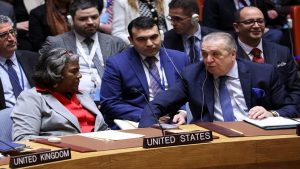The US Federal Reserve decided Wednesday to keep its benchmark interest rate unchanged amid mixed signals about the direction of the US economy.
While the central bank noted the continued “strong labor market” and “solid” gains in economic activity, it also highlighted a slowdown in investment by businesses and households and inflation, which has fallen below the Fed’s target.
After raising the key lending rate four times last year, the Fed voted unanimously to keep it in a range of 2.25-2.5 percent.
Conflicting economic data has complicated the Fed’s decision-making, while repeated attacks by President Donald Trump have left the institution open to concerns it might bow to political pressure.
But Fed Chair Jerome Powell stressed, “We think that our policy stance is appropriate at the moment. And we don’t see a strong case for moving in either direction.”
Asked whether there was a case building to cut rates to push inflation closer to the Fed’s two percent target, Powell told reporters central bankers are “comfortable” about policy at the moment.
And he defended the committee’s actions to date, saying they were not responsible for low inflation which in part is due to factors that “appear to be transient or idiosyncratic.”
But he said policymakers will be “watching inflation carefully.”
Powell also again stressed that the Fed does not respond to political pressure.
He said “we don’t think about short term political considerations, we don’t discuss them and we don’t consider them in making our decisions one way or the other.”
The statement by the rate-setting Federal Open Market Committee offered just a few key changes of language.
Data since the March policy meeting show “the labor market remains strong and that economic activity rose at a solid rate,” the statement said, somewhat more optimistic than the prior statement that noted slowing activity.
– Small change, no surprises –
But the FOMC also noted growth in household spending and business fixed investment “slowed in the first quarter,” and that key inflation measures “have declined and are running below 2 percent.”
There also was one shift: a small reduction on interest paid to banks on cash reserves to 2.35 percent from 2.4 percent. Powell called it just a “technical fix” to the mechanism for controlling policy.
Some economists predicted that move, saying the actual federal funds rate had been drifting up to the higher end of the desired range.
That change is “intended to foster trading in the federal funds market well within the FOMC’s target range,” the FOMC statement said.
In the first two meetings of the year, central bankers had made it clear they planned to hold off on any further moves until there were clear signs of the direction of the economy.
The Fed’s mandate is full employment and stable prices.
But central bankers have been baffled that wages and prices have shown few signs of taking off, even with unemployment at historic lows, companies nationwide complaining of struggles to find workers, and solid GDP growth of 3.2 percent in the first three months of 2019.
Many economists point to the weakness underlying the strong GDP data and say the last rate hike in December was a mistake. Even so, near-record stock markets make it harder for the Fed to cut.
And while Powell acknowledged the rising financial markets, he said while “some asset prices are somewhat elevated but I would say not extremely so.”
Jim O’Sullivan of High Frequency Economics said the statement offered “nothing very surprising” and “no indication that officials are prepared to ease to push inflation higher.”
“We think they are just more likely to refrain from tightening in response to still-fairly-strong labor market trends,” he said in a client note.






